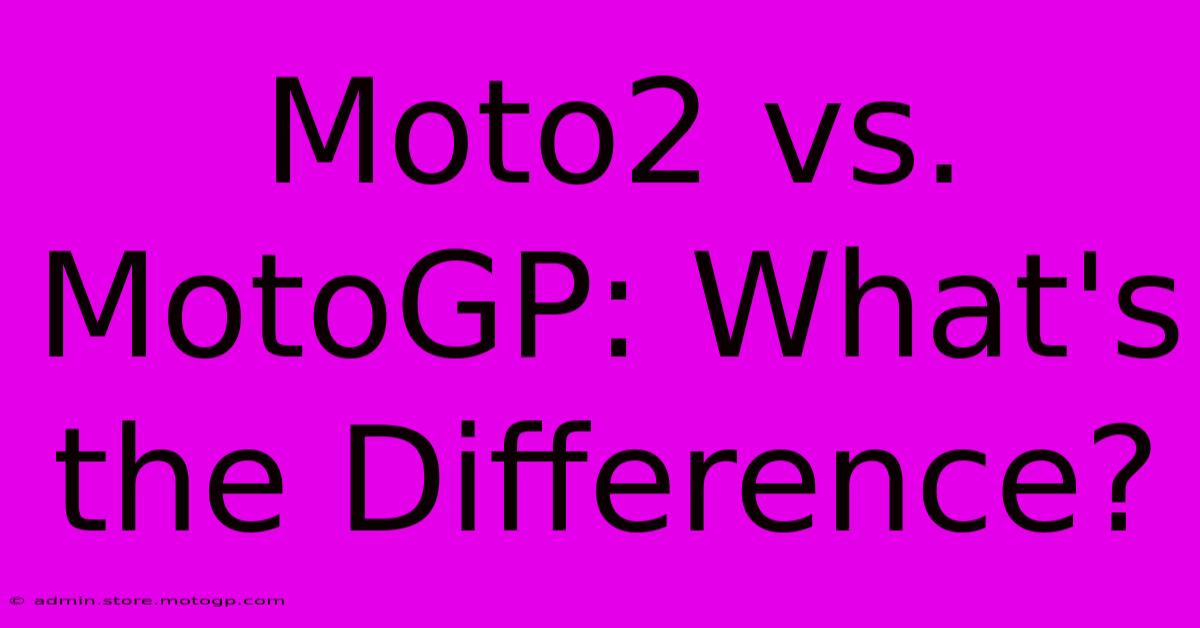Moto2 Vs. MotoGP: What's The Difference?

Table of Contents
Moto2 vs. MotoGP: What's the Difference?
For motorsport enthusiasts, the roar of powerful engines and the thrill of high-speed racing are captivating. But within the world of Grand Prix motorcycle racing, there's a clear hierarchy. Two prominent classes often draw comparisons: Moto2 and MotoGP. While both showcase incredible skill and breathtaking maneuvers, understanding their key distinctions is crucial for appreciating the nuances of each. This article will delve into the core differences between Moto2 and MotoGP, exploring everything from engine specifications to rider experience.
Engine Power and Technology: A World Apart
The most significant difference between Moto2 and MotoGP lies in their engines. This disparity shapes the entire racing dynamic.
Moto2: Standardized Power
Moto2 utilizes a single, standardized 765cc Triumph triple-cylinder engine. This specification levels the playing field, emphasizing rider skill and chassis setup above engine development. Teams focus on optimizing suspension, aerodynamics, and electronics within the constraints of the shared powerplant. This makes Moto2 a fantastic proving ground for upcoming talent, focusing on pure riding ability rather than immense financial investment in engine technology.
MotoGP: Open-Class Powerhouses
MotoGP, on the other hand, is an open-class championship where manufacturers like Yamaha, Honda, Ducati, Suzuki, and KTM develop and supply their own highly sophisticated prototype engines. These are cutting-edge, high-performance machines, typically with 1000cc capacity and producing significantly more horsepower than the Moto2 engines. This technological arms race leads to constant innovation and pushes the boundaries of motorcycle engineering. The result? Faster lap times and more intense competition.
Electronics and Rider Aids: A Sophisticated Gap
The technological chasm between the two classes extends beyond the engine.
Moto2: Controlled Electronics
Moto2 employs a standardized Magneti Marelli ECU (Electronic Control Unit), limiting the extent of electronic rider aids. This standardization further emphasizes the rider's skill in controlling the machine. While some electronic assists are present, their capabilities are regulated, preventing an excessive reliance on technology.
MotoGP: Cutting-Edge Electronics
MotoGP bikes boast highly advanced and sophisticated electronics packages, tailored by each manufacturer. These systems manage engine braking, traction control, wheelie control, and launch control with incredible precision, aiding riders in pushing the limits of performance. The sophisticated electronics are a key differentiator, allowing for incredibly fine-tuned control and exceptional performance at the highest levels of motorcycle racing.
Tire and Chassis Differences: Subtle but Significant
While engine technology dominates the conversation, other factors also contribute to the disparity between the classes.
Moto2: Spec Tires and Chassis
Moto2 uses spec tires supplied by Dunlop, ensuring a level playing field. Chassis construction is also less complex than in MotoGP, with teams focusing on optimizing the existing framework rather than designing ground-breaking new chassis technologies.
MotoGP: Manufacturer-Specific Choices
MotoGP teams enjoy significantly more freedom in tire and chassis development. They partner with tire manufacturers (like Michelin) and develop their own unique chassis designs, allowing for highly customized setups optimized for individual rider preferences and track conditions. This freedom fuels innovation and contributes to the dramatic performance differences between manufacturers.
Rider Skill and Experience: A Gradual Progression
The Moto2 class frequently serves as a crucial stepping stone for aspiring MotoGP riders. It allows them to hone their skills in a competitive environment before moving up to the premier class. While Moto2 requires exceptional talent, the transition to MotoGP necessitates adapting to vastly more powerful machines and sophisticated electronics, demanding a higher level of experience and finesse.
Conclusion: Distinct Divisions, Shared Passion
In essence, the differences between Moto2 and MotoGP are substantial. Moto2 provides a standardized platform that emphasizes pure riding skill, while MotoGP showcases the pinnacle of motorcycle technology and engineering. Both classes, however, are integral parts of Grand Prix motorcycle racing, each contributing to its unique blend of excitement, competition, and innovation. The shared passion for speed, precision, and the thrill of high-stakes racing unites them both.

Thank you for visiting our website wich cover about Moto2 Vs. MotoGP: What's The Difference?. We hope the information provided has been useful to you. Feel free to contact us if you have any questions or need further assistance. See you next time and dont miss to bookmark.
Featured Posts
-
The Ultimate Collectors Item Limited Edition Replica Helmets
Feb 20, 2025
-
Red Bull Grand Prix Witness History In The Making
Feb 20, 2025
-
Cota Track Day Make Your Mark On The Track
Feb 20, 2025
-
Show Your Team Spirit Officially Licensed Replica Helmets
Feb 20, 2025
-
Cota Open Track Days Where Legends Are Made
Feb 20, 2025
